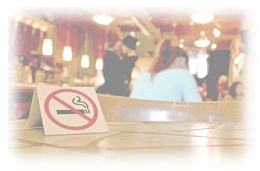 |
Reports according to Master's order and rating
Smoking – On Its Way Out
Authorities in many countries around the world are becoming more mindful of their citizens’ health by taking full action against tobacco smoking and eliminating passive smoking.By Florida News Group (Originally in English)
In Europe
On March 21, 2006, the first-ever report on deaths in the EU from passive smoking was presented in the EU Parliament by MEPs Liz Lynne (UK) ♥♥♥♥and Adamos Adamou (Cyprus)♥♥♥♥. The report, entitled “Lifting the Smokescreen,” concluded that 79,000 Europeans die every year due to cancer-related passive smoking.
What is most intriguing about the new report is its explanation of how previous flawed studies have been used in the past as a “smokescreen” to delay EU smoking bans. In the past, tobacco companies have argued that it was too difficult to measure cancer risks due to secondhand smoke. This turned people’s attention away from an obvious fact: secondhand smoke is the same deadly substance that is known to kill smokers. The EU report refers to 800 secret passive smoking experiments performed by tobacco companies on animals, some of which found that chemicals released from cigarettes held in the hand or an ashtray were far more deadly than those inhaled because the cigarettes burned at a lower temperature.1
The report also refers to a series of studies on the effects of new smoking bans in European countries. Most recently, a study was released on February 20 in Norway which measured improvements in air quality and health factors in workers after the recent smoking ban in Norway. 2
 The
EU report provides a solid scientific basis for a future EU-wide
ban on public smoking. Ms. Lynne announced, "A comprehensive
ban is the only way forward to ensure employees and customers
are fully protected…I am delighted that the UK will be
enforcing a total ban on smoking in public places from next
summer. Those member states [that] have not already done so
must follow suit."
3
The
EU report provides a solid scientific basis for a future EU-wide
ban on public smoking. Ms. Lynne announced, "A comprehensive
ban is the only way forward to ensure employees and customers
are fully protected…I am delighted that the UK will be
enforcing a total ban on smoking in public places from next
summer. Those member states [that] have not already done so
must follow suit."
3
Also, on March 26, 2006, a new era began in Scotland♥♥♥♥♥when a complete ban on smoking in public buildings came into effect, part of a broad new public health campaign which includes free eye exams for all citizens. The smoking ban is enforced by a new corps of uniformed smoking officers, who are authorized to collect a £50 (US$90) fine for smokers, and a £200 (US$450) fine for owners of buildings where people smoke.
The law has been such a success that not a single fine has been imposed. The government has received a few reports of smoking through the new “national compliance hotline,” but these cases were solved easily through warning letters. A health officer said, “The levels of compliance are phenomenal.”
The ban has broad support from the public. Even among Scottish smokers, 70% now say they would like to quit. 4 Calls to the national “quitline,” which gives advice to help smoker’s quit, have quadrupled since the ban. Calls to the quitline were already twice as high in 2005 as in previous years, due to anticipation of the ban. 5
 The
ban is a result of several courageous acts of leadership. It
all began in March 2004, when the former health minister of
nearby Ireland, Micheál Martin,♥♥♥♥♥ imposed a national ban,
in the face of immense opposition from traditional Irish pub
owners. This set off shockwaves around the world. Delegations
from other countries came to Ireland to study the law, including
Scottish First Minister Jack McConnell. McConnell♥♥♥♥♥had suggested
that a complete ban would not work in Scotland, but after his
visit to Ireland, he announced that a ban would be enacted within
a year. UK-wide bans have since been passed and will be in effect
by summer 2007. 6
The
ban is a result of several courageous acts of leadership. It
all began in March 2004, when the former health minister of
nearby Ireland, Micheál Martin,♥♥♥♥♥ imposed a national ban,
in the face of immense opposition from traditional Irish pub
owners. This set off shockwaves around the world. Delegations
from other countries came to Ireland to study the law, including
Scottish First Minister Jack McConnell. McConnell♥♥♥♥♥had suggested
that a complete ban would not work in Scotland, but after his
visit to Ireland, he announced that a ban would be enacted within
a year. UK-wide bans have since been passed and will be in effect
by summer 2007. 6
“Nobody now doubts that an EU-wide ban is possible,” said Professor Luke Clancy, chairman of Action on Smoking and Health (ASH)-Ireland. “What a difference a couple of years can make in such an important health issue.” 7 Italy♥♥♥♥♥, Norway♥♥♥♥♥, Sweden♥♥♥♥♥, Spain♥♥♥♥♥, Belgium♥♥♥♥♥, and Ukraine♥♥♥♥♥ all passed bans since Ireland’s. On March 28, 2006, Denmark ♥♥♥♥♥announced a nationwide ban.
Even in Turkey where 60% of men smoke, Prime Minister Recep Tayyip Erdogan is spearheading a radical new smoking law, which will impose limited bans and require TV producers to blur out cigarettes shown on TV programs. Meanwhile, on March 1st, Uruguay♥♥♥♥♥ became the first Latin American country to impose a strict nationwide ban.
In the USA
New York City ♥♥♥♥♥
In December, 2005, the City of New York launched a campaign
for “A Smoke-free Home” in order to protect the
health of pets and children.
8
These oft-forgotten victims of passive smoking are frequently
confined throughout the day in smoky households. Recent studies
have found up to 400% higher incidence of feline lymphoma, the
most common cancer of cats, in cats living in smoking households,
9
and 250% increase in nasal cancer among dogs.10
Secondhand smoke increases various respiratory problems in dogs,
cats, and birds. It can be deadly for infants and causes respiratory
disease, malformed lungs, and ear infections in children. ![]()
Refer this page to friends |
||